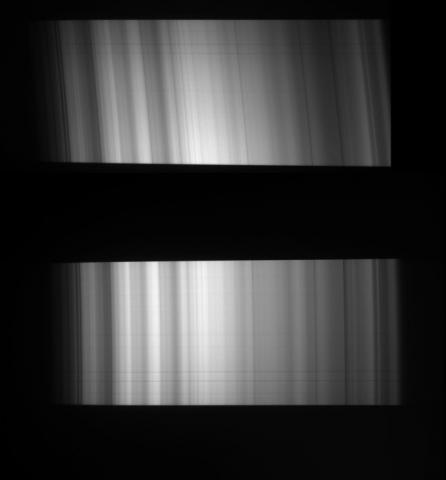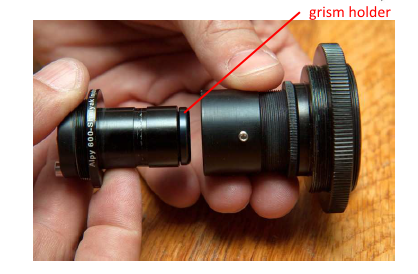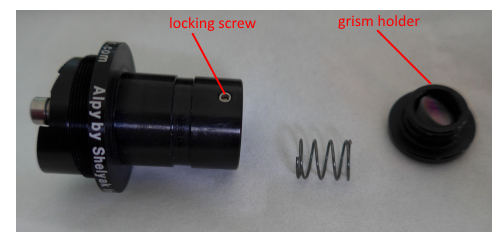Forum Replies Created
-
AuthorPosts
-
 Robin LeadbeaterParticipant
Robin LeadbeaterParticipantI am not a member of the “12a Collaboration” but there must be some of the VSS Section who are on here. If not, I am sure an email to Dr Matt Darnley at LJMU would bring you up to speed if you want to join the collaboration.
Cheers
Robin
 Robin LeadbeaterParticipant
Robin LeadbeaterParticipantIf you are interested in following a white dwarf binary system that might “soon” become a type 1a supernova then M31N 2008-12a could be a good bet. Matt Darnley talked about it at NAM this year
https://nam2019.org/thursday/details/23/327
https://nam2019.org/thursday/details/23/445
Robin
 Robin LeadbeaterParticipant
Robin LeadbeaterParticipantYes the progenitor of the LMC supernova SN 1987A, Sanduleak -69 202 had been catalogued spectroscopically as a blue supergiant prior to it going supernova. I am not aware of any observed outbursts before it exploded though.
If 2010oct and 2017ein (correction 201oct and 2019cda) don’t turn out to be the same object then other examples of impostors apparently later exploding for real as supernovae are 2006jc and 2009ip
 Robin LeadbeaterParticipant
Robin LeadbeaterParticipantYes extra galactic supernova progenitors are just faint stars among billions so until we get another supernova in our own galaxy, there are very few observations of supernova progenitors, mostly found in deep images eg archive HST images. All are of core collapse types as they are produced by luminous stars eg supergiant and Wolf Rayet stars, for example
https://www.spacetelescope.org/images/opo1847b/
The progenitor of sn 2017ein discovered by Ron Arbour
Robin
 Robin LeadbeaterParticipant
Robin LeadbeaterParticipantThere are cases of stars which have had previous outbursts and then gone supernova, as in this one found by Ron Arbour
https://britastro.org/node/17595
Cheers
Robin
 Robin LeadbeaterParticipant
Robin LeadbeaterParticipantHi Kevin,
Concerning instrument response/atmospheric extinction, Christian Buil has been moving away from the reference star at the same air mass method recently.
http://www.astrosurf.com/buil/instrument_response_us/
Essentially he is separating out the true response of the instrument which he reuses, from the atmospheric extinction which he models. Although this is similar to the technique pros use, I am not totally convinced about this for my atmospheric conditions so am currently still using the old reference star as similar air mass method, though I do admit to reusing instrument responses quite freely for H alpha at high resolution with the LHIRES where the atmospheric extinction effect is small. David Boyd was at OHP this year so perhaps he has some updates on this new method?
I think your method of reusing the dispersion equation should work well with the ALPY provided the temperature does not change too much as it seems very stable to me. I would suggest still taking a lamp spectrum and using a lamp line as a single anchor point to avoid any problems with overall shifts. You could also use this lamp spectrum to make sure there has been no change in dispersion eg due to temperature by checking the position of second line in the spectrum
Cheers
Robin
 Robin LeadbeaterParticipant
Robin LeadbeaterParticipantHi Paul,
They look like trails of hot pixels. Is this an aligned sum of several individual exposures?
(IC1296 brings back memories. It was a test of how deep I could go with my first astro camera, a surveillance camera which I modified for long exposures in 2002).
http://www.threehillsobservatory.co.uk/astro/1004xcam.htm
The resulting LRGB image of M57 even made it into Astronomy Now. Cutting edge then !
 Robin LeadbeaterParticipant
Robin LeadbeaterParticipantThe thing is though the content is irrelevant. It is all about clicks and we are playing their game.
 Robin LeadbeaterParticipant
Robin LeadbeaterParticipantCome on, give the author a break. When you have got 2281 articles to write and you have a serious twitter account to maintain you’re bound to get a few things wrong
https://muckrack.com/shivali-best
🙂
 Robin LeadbeaterParticipant
Robin LeadbeaterParticipantCertainly more have been seen than that article suggests. (Wikipedia lists 7 not including Shoemaker Levy). Marc Delcroix coordinates an amateur programme for Jupiter and Saturn impacts. Based on their coverage they estimate a rate for potentially detectable Jupiter impacts of ~6/year
http://www.astrosurf.com/planetessaf/doc/project_detect.php
Robin
 Robin LeadbeaterParticipant
Robin LeadbeaterParticipantHi Derek
Not all candidate supernovae turn out to be supernovae, for example they may turn out to be novae, Luminous Blue Variable outbursts or other cataclysmic variables in our own galaxy. A follow up spectrum is needed to establish exactly what type of object it is. (For example the redshift measurement can be used to confirm if it is extra-galactic and the width of the lines can be used to measure the velocity of the material flung out in the explosion which is much higher for supernovae.There are also different types of supernovae produced by different mechanisms, for example core collapse of massive stars or the thermo-nuclear explosion of a white dwarf following accretion of material from a companion. These different types of event have characteristic spectral features and are very different from what the spectrum would have been before the explosion.
An introductory paper on the subject is one by Filippenko here
https://ned.ipac.caltech.edu/level5/March03/Filippenko/frames.html
also brief but more up to date this blog entry
https://astrobites.org/2016/12/02/classifying-supernovae/
I have talked more about this and how I am using spectroscopy to confirm and classify supernovae spectroscopically in more detail in a few BAA meetings a couple of which were videoed
https://britastro.org/video/11250/12234
https://britastro.org/video/13862/14769
Also short more up to date piece on the Sky and Telescope website currently
Cheers
Robin
 Robin LeadbeaterParticipant
Robin LeadbeaterParticipantHi Roger,
It might be interesting to look at the original (and any subsequent published) light curves of these proposed planetary systems to check what the unexplored orbital period/transit depth space looks like? For example why would HATNet have not found the other potential planets in the HAT-P-19 system listed in table 2? Also, in additional to the effect of inclination, it should be possible, given a maximum size of planet and a minimum detectable transit depth, to estimate the maximum orbital period it is worth looking at for each system.
Interestingly, there is another similar proposal currently being discussed on Stargazer’s Lounge. They are planning to look for very shallow transits to 0.1%, though I am not convinced that amateurs could do this for transits of unknown timing and duration.
Cheers
Robin
 Robin LeadbeaterParticipant
Robin LeadbeaterParticipantHi David,
I’ve sent you an email
Robin
 Robin LeadbeaterParticipant
Robin LeadbeaterParticipantHi David,
I don’t get to CAS very often these days, mainly when they need a speaker.
That is a curious design change. The big advantage with the ALPY is that provided everything is tightened up, it is a very stable instrument.
(The forum compresses large images to a smaller size but if you upload them as an attachment rather than an image, the original size and quality is maintained. It is also fussy about the file type. In any case 2MB is the maximum size allowed)
Cheers
Robin
 Robin LeadbeaterParticipant
Robin LeadbeaterParticipantThis is how the sky spectrum looked when my ALPY arrived (one of the first batch in 2013) and how it looked after adjusting the Grism (full size in attachment)

 Robin LeadbeaterParticipant
Robin LeadbeaterParticipantAre you “local” then? I am in North Cumbria near Cockermouth
Interesting I was not aware they had changed the design Is the grism holder threaded now?. I have 4 grism holders (the one from my original beta model ALPY 600, the one I used to build the ALPY200, one I got through the BAA supported program and one I bought a few months back for another experiment.) All just have a plain barrel with stepped groove for the grub screw. This is the component I mean


Cheers
Robin
 Robin LeadbeaterParticipant
Robin LeadbeaterParticipantHi David,
It is almost certainly the grism holder that that has come loose and is rotating relative to the slit. (It seems to be a quite common problem. Not sure why but I suspect Shelyak dont always tighten them up properly when the leave the factory as I have never had one move on its own after tightening. It is easy to fix though. The grim is held in the core module by an allen headed grub screw(s?). You view the sky spectrum for example visually through the core module, and rotate the grism until the spectrum is square and tighten. It is worthwhile getting it as precisely square as possible otherwise the ISIS software automatic wavelength calibration can fail. You can see a picture of the assembly here (page 4)
http://www.threehillsobservatory.co.uk/astro/ALPY200_VdS_BAAVSS_poster_2014.pdf
Take care if you slacken the grub screw off too far ,there is a spring underneath the grism assembly that holds the collimator lens in place which can launch everything if you are not careful!
Cheers
Robin
 Robin LeadbeaterParticipant
Robin LeadbeaterParticipantIt turns out there is historic evidence from MASTER that AT2019lvs is a recurrent object with several historic outbursts
 Robin LeadbeaterParticipant
Robin LeadbeaterParticipantUpdate:
The optical transient AT2019lvs is now reported seen by PAN-STARRS 18 hours before the GW event. There is also a faint possible precursor visible on the SDSS image so most likely just a CV and not associated with the GW event see GCN 25204
https://gcn.gsfc.nasa.gov/gcn3/25204.gcn3
I also see that it is now reported outside the updated region of the sky
https://gcn.gsfc.nasa.gov/gcn3/25207.gcn3
and as I type, spectroscopic confirmation that it is indeed a CV
https://gcn.gsfc.nasa.gov/gcn3/25209.gcn3
so a false alarm this time I am afraid
Robin
 Robin LeadbeaterParticipant
Robin LeadbeaterParticipantYes the “junk box” approach is a simple alternative to 3D printing these “linear” transmission spectrograph designs. eg
http://www.threehillsobservatory.co.uk/astro/spectroscopy_19.htm
http://www.threehillsobservatory.co.uk/astro/spectroscopy_18.htm
though I never got round to coupling them to the ALPY mirror slit guider
Claudio Balcon in Italy has recently classified a couple of faint supernovae using a similar home built collimated Star Analyser 100 setup
-
AuthorPosts
